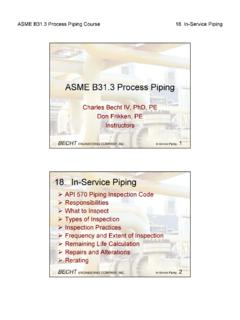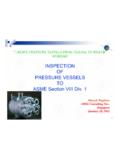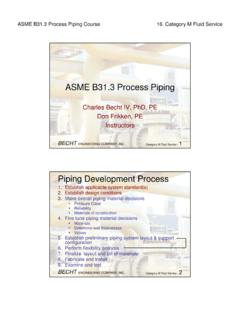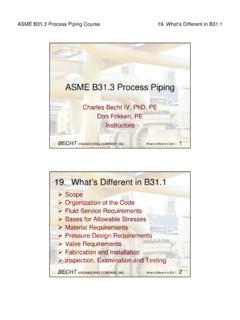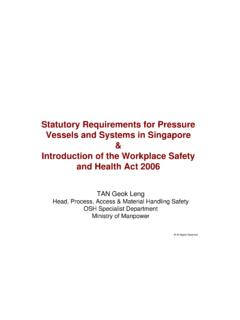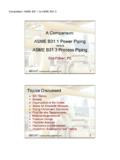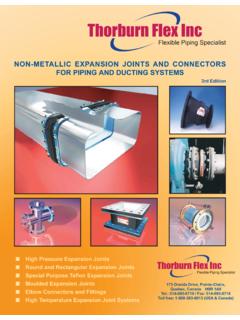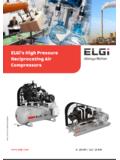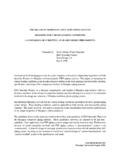Transcription of ASME B31.1 to B31.3 Comparision.ppt - psig.sg
1 Comparison: asme to asme Comparison: asme power PipingversusASME Process PipingBECHTENGINEERING COMPANY, Frikken, PETopics Discussed B31 History Scopes Organization of the Codes Organization of the Codes Bases for Allowable Stresses piping Component Standards Fluid Service Requirements Material Requirements Pressure DesignBECHTENGINEERING COMPANY, Flexibility Analysis Fabrication and Installation Inspection, Examination and TestingComparison: asme to asme In the mid 1800 s, boiler explosions were occurring at the rate of oneB31 Historyrate of one every four days On April 27, 1865 the boiler explosion on the Sultana killed 1800 returning civil war soldiersBECHTENGINEERING COMPANY, -3 From 1898 to 1903, more than 1200 people were killed in the in 1900 separate boiler explosions. The catastrophic explosion of a fire tube boiler in a factory in Brockton, Massachusetts, in 1905 killed 58 people B31 History asme formed a committee to address the boiler explosion problem - 1911 asme Boiler and Pressure Vessel Code asme Boiler and Pressure Vessel Code (BPVC) was the first comprehensive standard for the design, construction, inspection, and testing of boilers and pressure vessels - 1915 American Standards Institute initiated a project to develop a piping code - 1926 BECHTENGINEERING COMPANY, -4 American Tentative Standard code for Pressure piping 1935 Separate sections were split off starting in 1955 Comparison.
2 asme to asme piping CodesPIPELINE Liquid Transportation Gas Transportation Slurry Transportation PipelinesBECHTENGINEERING COMPANY, -5B31 piping CodesPIPING power Process Refrigeration Building Services PipingBOTHBECHTENGINEERING COMPANY, -6 BOTH Hydrogen piping and PipelinesComparison: asme to asme piping Codes Each Code provides a set of requirements fbtiif libl dfor obtaining a safe, reliable and economical installation. The designer is cautioned that the Code is not a design handbook; it does not eliminate the need for the designer or forBECHTENGINEERING COMPANY, -7eliminate the need for the designer or for competent engineering piping System StandardsBPE1 Bioprocessing EquipmentBPE-1 Bioprocessing EquipmentPVHO-1 Pressure Vessels for Human OccupancyB&PV Code, Section III for Nuclear power PlantsBECHTENGINEERING COMPANY, -8 Comparison: asme to asme USA piping System StandardsNFPA 13 Installation of Sprinkler SystemsNFPA 24 Installation of Private Mainssa a o oae a sNFPA 50 Bulk Oxygen Systems NFPA 54 National Fuel Gas Code CGA Handling of Anhydrous Ammonia ( )Chlorine Institute #6 piping Systems for ChlorineBECHTENGINEERING COMPANY, and ScopesRules have been developed considering piping typically found inpp g ypyelectric power generating stations, industrial and institutional plants, geothermal heating systems and central andpetroleum refineries.
3 Chemical, pharmaceutical, textile,paper, semiconductor, and cryogenic plants; andBECHTENGINEERING COMPANY, and central and district heating and cooling systems. ( ) asme cryogenic plants; and related processing plants and terminals. ( ) asme : asme to asme and ScopesPower piping systems ..include but are not limited toThis Code applies for all fluids, including:(1)itditdlimited to steam water oil gas air(1)raw, intermediate, and finished chemicals;(2) petroleum products;(3) gas, steam, air, and water;(4)fluidized solids; air [ ]();(5) refrigerants; and(6) cryogenic fluids.[ (b)]BECHTENGINEERING COMPANY, s Different in provides requirements for types of piping Boiler provides requirements for fluid services Blowoff and Blowdown Instrument, Control and Sample Spray Type Desuperheater Pressure Relief Flammable or Combustible Liquids Flammable Gases and Toxic FluidsPi ifCiFl id Category D (utility) Category M (lethal) Elevated Temperature (creep range) High Pressure (above about 100 MPa) High Purity piping for Corrosive Fluids Temporary Steam Trap Pump Suction and Discharge District Distribution Systemsgy Normal (Process) Severe Cyclic ConditionsBECHTENGINEERING COMPANY, s Different in -12 Comparison.
4 asme to asme of the CodesIScope and DefinitionsIIDesigngIIIM aterialsIV Dimensional RequirementsVFabrication, Assembly, and ErectionVIInspection, Examination and TestingBECHTENGINEERING COMPANY, , Examination and TestingOrganization of the CodesVII Operation and MaintenanceVII Nonmetallic piping and piping Lined with NonmetalsAppendices covering: Nonmetallic piping and piping Lined with Nonmetals Design of Safety Valve ItlltiNonmetalsVIII piping for Category M Fluid ServiceIXHigh Pressure PipingXHigh Purity PipingInstallations Corrosion Control Restrained Underground PipingAppendices covering: Aluminum Alloy Flanges Expansion JointsBECHTENGINEERING COMPANY, s Different in -14 Comparison: asme to asme for Design The lowest of the specified minimum tensile strength divided by The lowest of the specified minimum tensile strength divided by tensile strength at temperature divided by 2/3 of specified minimum yield strength 2/3 of yield strength at temperature; except forby 3 tensile strength at temperature divided by 3 2/3 of specified minimum yield strength 2/3 of yield strength at temperature; except fortemperature; except for austenitic stainless steels, 90% of yield strength at temperature Creep strength criteriatemperature.
5 Except for austenitic stainless steels, 90% of yield strength at temperature Creep strength criteriaBECHTENGINEERING COMPANY, s Different in -15 Bases for Design StressesASTM A106 Grade B Carbon Steel (US Customary Units)BECHTENGINEERING COMPANY, : asme to asme Component Standards StandardComponents:Those listed by standard ListedComponents:Those listed by standard number inlisted by standard number in Table , which lists material specifications (ASTM) as well as component standardsstandard number in Table and Appendix A UnlistedComponents:Those not so standards NonstandardComponents:Those not so COMPANY, s Different in -17 Nonstandard/Unlisted ComponentsCan be used if they: adherence to dimensional standards of ANSI and asme itlCan be used if they: are checked for adequacy of mechanical strength dliblASME is strongly recommended when practicable , and Meet the pressure design formulas and procedures given in para. 104[104 126 2]under applicable , and composition, mechanical properties, method of manufacture, and quality control are comparable to li t dt d[104, ]listed components ; and have pressure-temperature ratings that conform with para.
6 304[ , ]BECHTENGINEERING COMPANY, s Different in -18 Comparison: asme to asme Fluid Service Requirements Furnace butt welded pipe is not permitted for flammable Furnace butt welded pipe is permitted only for Category D fluidfor flammable, combustible or toxic fluids Soldered joints may not be used for flammable or toxicfor Category D fluid service (utility) Soldered joints may be used only for Category D fluidflammable or toxic fluidsCategory D fluid service (utility)BECHTENGINEERING COMPANY, s Different in -19 Selected Fluid Service Requirements Brazed joints may not be used for flammable or toxic fluids in fire Brazed joints are permitted for fluids that are flammable, toxic or dithhazard areas Threaded joint size limited by temperature and pressure; example max. pressure NPS 3 (DN 80) j i t i 400idamaging to human tissue only if safeguarded NPS 1-1/2 (DN 40) and smaller tapered joints mustbeSch80for(DN 80) joint is 400 psi (2750 kPa) Pipe thinner than STD WT may not be thr d dmust be Sch 80 for notch sensitive material in Normal ServiceBECHTENGINEERING COMPANY, s Different in -20 Comparison: asme to asme Requirements Listed Material:a material that conforms to a specification in Listed Material:a material that conforms to a specification ina specification in Appendix A or to a standard in Table may be used ( ) Unlisted Material:a material that is not so listed may be used a specification in Appendix A or to a standard in Table may be used ( ) Unlisted Material:a material that is not so listed may be used yunder certain conditions ( ) Unknown Material:may not be used ( )yunder certain conditions ( ) Unknown Material.
7 May not be used ( )BECHTENGINEERING COMPANY, s Different in -21 Material RequirementsAn unlisted material may be used if( ) It conforms to a published An unlisted material may be used if( ) It conforms to a published specification covering chemistry, mechanical properties, etc. Otherwise meets the requirements of the Code Allowable stresses are specification covering chemistry, mechanical properties, etc. Otherwise meets the requirements of the Code Allowable stresses are determined in accordance with Code bases, and Qualified for all temperaturesdetermined in accordance with Code bases, and Qualified for all temperatures ( )BECHTENGINEERING COMPANY, s Different in -22 Comparison: asme to asme Requirements Materials for BEP must be asme B&PV Code materialsCode materials Use at temperatures above maximum in the stress tables is generally not permitted Use at temperatures above maximum in the stress tables is generally permittedpermitted No rules for use at temperatures below -20 F (-29 C) Extensive rules for use at temperatures below -20 F (-29 C)BECHTENGINEERING COMPANY, s Different in -23 Cast Iron Fluid Service LimitsGray IronGenerally limited to 250 psi (1725 KPa) saturated steam serviceMay not be used in flammable service above 150 psi (1035 kPa)May not be used in other services b400i (2760 kP )steam serviceabove 400 psi (2760 kPa)Malleable IronLimited to 350 psi (2415 kPa) and 450 F (230 C) Limited to -20 F to 650 F (-29 C to 343 C)Ductile Generally limited Generally limited to temperature BECHTENGINEERING COMPANY, temperature of 450 F (232 C)
8 And ratingsyprange of -20 F to 650 F (-29 C to 343 C) and ratingsComparison: asme to asme DesignThe rules for pressure design are essentially the same in and , but they are not COMPANY, Pressure & Temperatureallowance for pressure and temperature variation:The Codes allow the design pressure to be set below the most severe coincident pressurebe set below the most severe coincident pressure and temperature for the following variations: Can exceed allowable by 33% for no more than 10 hr/event and no more than 100 hr/year Can exceed allowable by 20% for no more than 1 hr/event and no more than 80 hr/yearBECHTENGINEERING COMPANY, Can exceed allowable by 20% for no more than 50 hr/event and nor more than 500 hr/year Can exceed allowable by 15% for no more than 8 hr/event and nor more than 800 hr/yearComparison: asme to asme AnalysisAcceptance Criteria for Sustained LoadsDead LoadsLive LoadsSL Sh[W]SL Sh[W]WindSL (Ec),BECHTENGINEERING COMPANY, s Different in -27 EarthquakeWater HammerorSL (Ec)Flexibility AnalysisAcceptance Criteria for Displacement LoadsS Sf [1 25(SS)S] Max.
9 Value of f is Use single Stress Intensification Factor Max. value of fis Use in-plane and out-of-plane Stress Intensification FactorsSE SA = f [ (Sc + Sh) SL] Provides SIF s for buttwelds, tapered transitions & reducersIntensification FactorsBECHTENGINEERING COMPANY, s Different in -28 Comparison: asme to asme Welder & brazer qualification and bending & forming requirements are very similar but not identicalnot identical Preheating and post weld heat treatment requirements are different, for example requires preheating to 200 F (95 C) orpost weld heat treatment for carbon steel with thickness less than or equal to 3/4 in (19 0 mm)BECHTENGINEERING COMPANY, less than or equal to 3/4 in. ( mm) requires neither preheating nor post weld heat treatment for the same thickness rangeInstallation Bolts must be threaded trough Bolts may be one thread short of a the nut Threaded joints that are intended to be seal welded shouldbe made upfull nut Threaded joints that are intended to be seal welded shallbe made upBECHTENGINEERING COMPANY, be made up without any thread be made up without any thread : asme to asme and Examination Authorized inspector required for boiler external piping asme Owner s Inspector is required to verify examination andexternal piping , asme B&PV Code, Section I Does not include the concept of random with progressiveexamination and testing was done correctly Does include the concept of random with progressivewith progressive either 100% or nonewith progressive examination, 5% random RTBECHTENGINEERING COMPANY, s Different in -31 ExaminationExamination required by Table.
10 Visual plusOver 750 F (400 C)For NPS 2 (DN 50), MP/LPFor NPS > 2 (DN > 50), 100% radiographyOver 1025 psig (70 b )d 350 tVisual plusFllthik (19 BECHTENGINEERING COMPANY, ) and 350 to 750 F (175 to 400 C)For wall thickness (19 mm), 100% radiographyAll OthersVisual onlyComparison: asme to asme required by para. 341:Category D (utility)Visual Onlygy(y)yNormal (Process)Visual plus 5% radiographyCategory M (lethal)Visual plus 20% radiographyElevated Temperature (creeprange)Visual plus 5% radiography100%LP/MPoffilletweldsBECHTEN GINEERING COMPANY, (creep range)100% LP/MP of fillet weldsHigh Pressure (above about 100 MPa)Visual plus 100% RTLeak Testing BEP requires hydrotest in accordance with asme B&PV Code, Section I Category D Fluid Service may be initial service leak testedB&PV Code, Section I Non BEP requires hydrotest or, at the owner s option, pneumatic, sensitive leak or initial service leak testingtested All other fluid services require hydrostatic or pneumatic testing Category M Fluid Service requires a sensitive leak test in addition to theBECHTENGINEERING COMPANY, Insulated systems may be tested by fluid loss over time methodtest in addition to the hydrostatic or pneumatic testComparison.

